NGC 5033
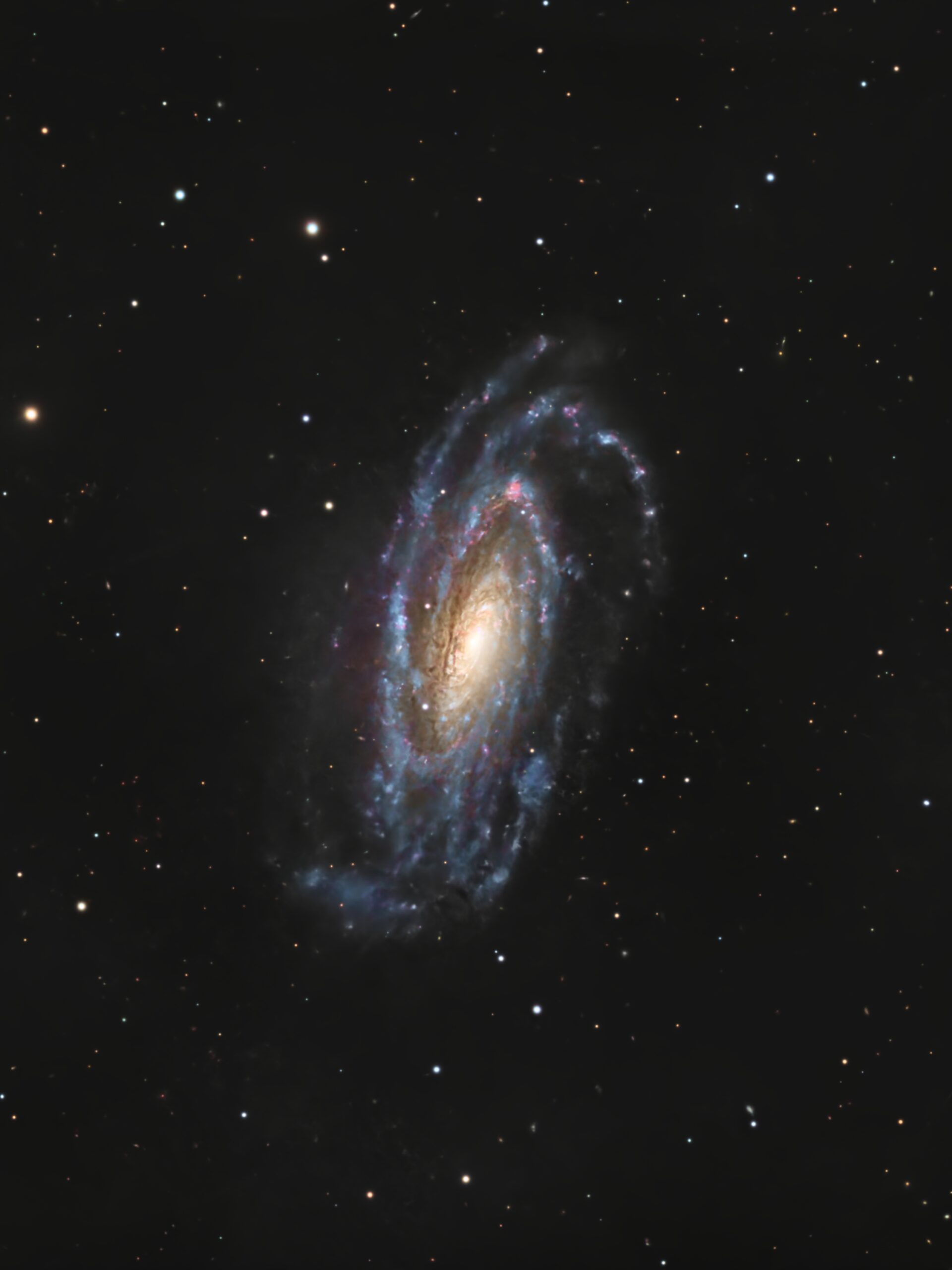 Click image for full size version
Click image for full size version
May 21,2025
NGC 5033 lies in the constellation Canes Venatici, the Hunting Dogs. It has a size a little larger than our own Milky Way galaxy, with an estimated mass 2 trillion times the mass of our sun and a 180,000 light yar diameter. It belongs to a class of galaxies called ‘Seyfert galaxies’ that have very bright cores likely powered by a supermassive black hole at their centre. One of the things that really puts the size of these galaxies in perspective for me is that every individual star that you see in this image is in the foreground — even those that appear “in” the galaxy. The galaxy is far in the distance — 40 to 60 million light years — and between us and it is mostly empty space.
Tekkies:
Acquisition, focusing, and control of Paramount MX mount with N.I.N.A., TheSkyX and PHD2. Primalucelab low-profile 2″ Essato focuser and ARCO rotator. Guiding with PHD2. Equipment control with PrimaLuce Labs Eagle 4 Pro computer. Flats taken using a Primalucelab Giotto 430 mm flat panel. All pre-processing and processing in PixInsight. Acquired from my SkyShed in Guelph. Data acquired under a nearly full Moon with average or better transparency and and average seeing between May 8 – 15, 2025.
Celestron 14″ EDGE HD telescope at f/11 (3,912 mm focal length) and QHY600M camera binned 2×2 with Optolong filters.
26 x 5m and 1 x 2m Red = 2hr 12m
23 x 5m Green = 1hr 55m
22 x 5m Blue = 1hr 50m
320x 5m Ha = 1hr 40m
Total: 7hr 37m
Preprocessing: The WeightedBatchPreProcessing script was used to perform calibration, cosmetic correction, weighting, registration, integration and Drizzle integration of all frames (1x drizzle, 0.9 Drop Shrink).
RGB and SynthL masters: A master RGB image was made from the Red, Green and Blue Drizzled masters using ChannelCombination in RGB mode. A synthetic luminance (SynthL) master was made from all four masters using ImageIntegration with weighting by SNR.
Gradient Removal: Spectrophotometric Flux Calibration followed by Multiscale Gradient Correction was applied to the RGB master. DynamicBackgroundExtraction was applied to the SynthL and Ha masters.
Colour Calibration: BlurXterminator was applied to the RGB master with Correct Only selected, followed by ColorCalibration.
Deconvolution: BlurXterminator was applied to the RGB, SynthL, and Ha masters with Automatic psf , star sharpening set to 0.5, and non-stellar set to 0.9.
Linear Noise Reduction: NoiseXterminator was applied to the RGB, SynthL, and Ha masters with settings Amount=0.9 and Detail=0.25.
Ha Continuum Subtraction: The ContinuumSubtraction script, by Jurgen Terpe, was used to remove continuum emissions from the Ha master using the red channel of the RGB master as the continuum reference image.
Stretching: HistogramTransformation was applied to make a pleasing image from the RGB, SynthL, and Ha masters. Approximate background level after stretch was 0.1 for SynthL and 0.08 for the Ha and RGB masters.
Nonlinear Processing
Luminance-RGB addition: LRGBCombination was applied to replace the lightness of the RGB image with the Luminance master.
Star Removal and processing: StarXterminator was used to remove the stars from the LRGB and Ha masters with Unscreen checked. The Ha stars were discarded. Colour was increased in the LRGB stars-only image by applying Curves saturation through a star mask.
Initial Saturation Boost: CurvesTransformation’s saturation tool was used to boost colour in the galaxies in the starless LRGB image using a range mask made with RangeSelection to protect the background.
H-alpha Blending: The contiuum-subtracted Ha was added to the LRGB image using Jurgen Terpe’s CombineHaWithRGB script.
Nonlinear Noise Reduction: NoiseXterminator was applied to the HaLRGB image with settings Amount=0.9 and Iterations=5. SCNR was applied (Green; average neutral, 60%).
Contrast Enhancement: Jergen Terpe’s CreateHDRImage script was applied to compress the dynamic range of the galaxy slightly. LocalHistogramEqualization was then applied three times. A Contrast Limit of 1.5 and 1 iteration was used for each application (scale 40, strength 0.25, scale 140, strength 0.25, and scale 300, strength 0.1). DarkStructureEnhance was applied with default settings except amount=0.15.
Sharpening: MultiscaleMedianTransform was used to sharpen Layers 1 – 5 with strengths of 0.03, 0.03, 0.03, 0.04, and 0.01, respectively.
Star Restoration: Stars were added back into the image using the PixelMath expression combine(starless, stars_only, op_screen())
Final Steps: Background, galaxy, and star brightness, contrast, and saturation were adjusted in several iterations using CurvesTransformation with masks as required. ICCProfileTransformation (sRGB IEC61966-2.1; Relative Colorimetric with black point compensation) was applied prior to saving as a jpg. The finder chart was made using the FindingChart process.

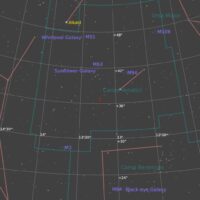
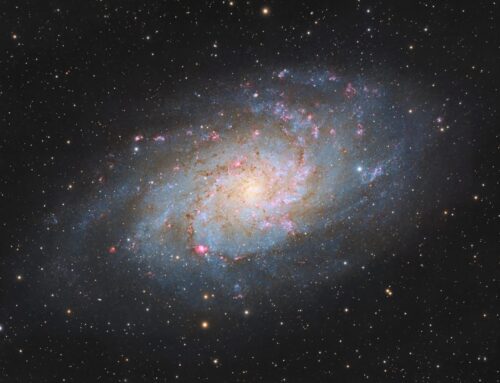

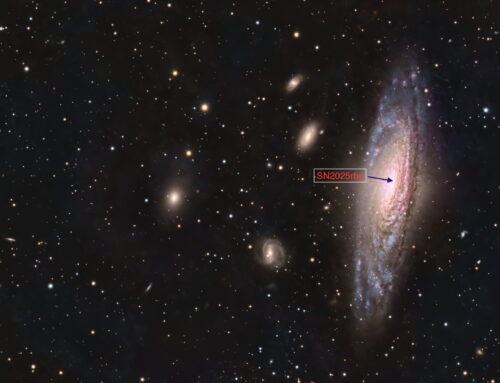
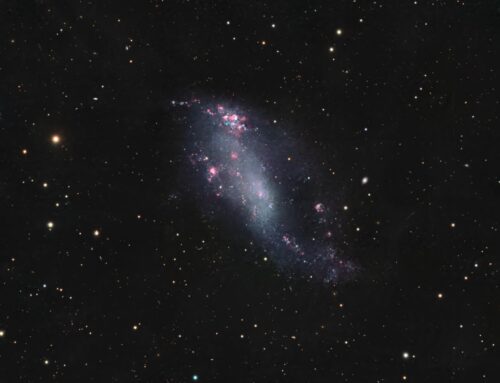
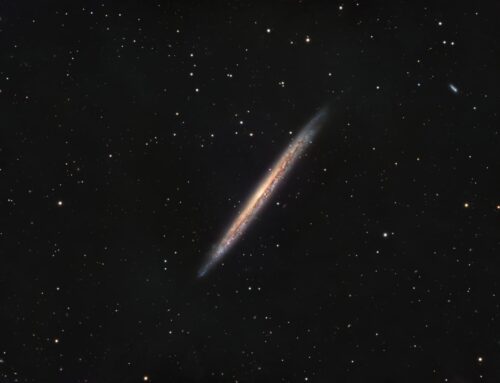
Wow so much post processing work but well worth it. This is a beautiful work of art!
Thank you!